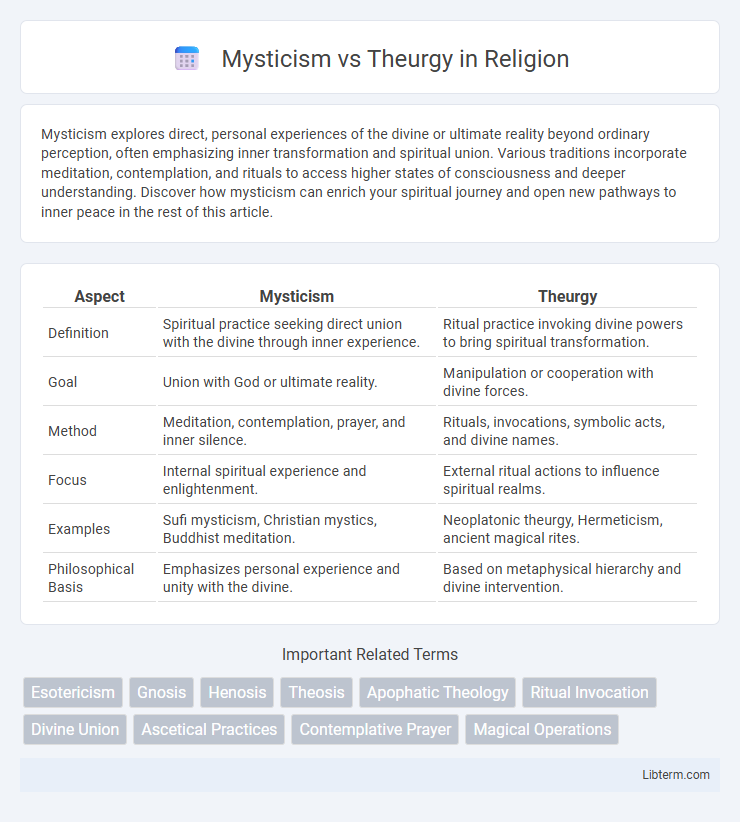Mysticism explores direct, personal experiences of the divine or ultimate reality beyond ordinary perception, often emphasizing inner transformation and spiritual union. Various traditions incorporate meditation, contemplation, and rituals to access higher states of consciousness and deeper understanding. Discover how mysticism can enrich your spiritual journey and open new pathways to inner peace in the rest of this article.
Table of Comparison
| Aspect | Mysticism | Theurgy |
|---|---|---|
| Definition | Spiritual practice seeking direct union with the divine through inner experience. | Ritual practice invoking divine powers to bring spiritual transformation. |
| Goal | Union with God or ultimate reality. | Manipulation or cooperation with divine forces. |
| Method | Meditation, contemplation, prayer, and inner silence. | Rituals, invocations, symbolic acts, and divine names. |
| Focus | Internal spiritual experience and enlightenment. | External ritual actions to influence spiritual realms. |
| Examples | Sufi mysticism, Christian mystics, Buddhist meditation. | Neoplatonic theurgy, Hermeticism, ancient magical rites. |
| Philosophical Basis | Emphasizes personal experience and unity with the divine. | Based on metaphysical hierarchy and divine intervention. |
Introduction to Mysticism and Theurgy
Mysticism explores direct, personal experiences of the divine or ultimate reality through practices such as meditation, contemplation, and prayer, aiming for spiritual union and inner transformation. Theurgy, rooted in Neoplatonism and Hermetic traditions, involves ritualistic practices designed to invoke divine powers and facilitate interaction with higher spiritual entities for achieving enlightenment or supernatural influence. Both Mysticism and Theurgy seek transcendent knowledge but differ in methods, with Mysticism emphasizing inward spiritual experience and Theurgy focusing on external ritual acts to engage cosmic forces.
Defining Mysticism: Core Concepts
Mysticism centers on direct, personal experience of the divine or ultimate reality through inner transformation, transcending ordinary perception and intellectual reasoning. Core concepts include union with the transcendent, spiritual illumination, and experiential knowledge beyond the material world. Mysticism emphasizes subjective encounters with sacred truth, contrasting with theurgical practices that prioritize ritual actions to invoke divine intervention.
Theurgy Explained: Origins and Principles
Theurgy, rooted in Neoplatonic philosophy, originated in late antiquity as a spiritual practice aimed at invoking divine powers through rituals and symbolic acts. Its principles center on achieving union with the divine by transcending the material realm, often involving the use of sacred texts, prayers, and ceremonial rites to facilitate spiritual transformation. Unlike mysticism's inward, contemplative approach, theurgy emphasizes active participation in divine work to elevate the soul and harness cosmic forces.
Historical Roots: Mysticism and Theurgy in Ancient Traditions
Mysticism and theurgy share intertwined historical roots in ancient traditions, with mysticism emphasizing inward spiritual experiences and direct union with the divine, often found in early Hindu, Buddhist, and Jewish Kabbalistic practices. Theurgy, rooted in Neoplatonism and practiced by figures like Iamblichus and Proclus, involves ritualistic techniques intended to invoke divine powers and facilitate interaction between humans and gods. Both emerged as parallel paths within spiritual systems of Late Antiquity, reflecting differing approaches to achieving divine knowledge and transformation.
Key Differences Between Mysticism and Theurgy
Mysticism primarily involves personal, direct experiences of the divine or ultimate reality through meditation, contemplation, and inner spiritual practices, aiming for transcendence and union with the divine. Theurgy, on the other hand, emphasizes ritualistic and ceremonial practices designed to invoke or cooperate with divine powers or intermediaries to achieve spiritual transformation or influence supernatural forces. Key differences include mysticism's inward, experiential focus versus theurgy's outward, action-oriented approach utilizing specific rites and symbolic acts.
Spiritual Goals: Union Versus Divine Intervention
Mysticism seeks direct union with the divine through personal spiritual experience and inner transformation, emphasizing self-realization and enlightenment. Theurgy involves ritual practices aimed at invoking divine forces or deities to intervene in the practitioner's spiritual development or worldly affairs. Both paths pursue spiritual elevation but differ fundamentally in their approach: mysticism centers on internal unity, while theurgy calls for external divine interaction.
Practices: Techniques in Mysticism and Theurgy
Mysticism emphasizes meditation, contemplation, and direct experiential union with the divine, often using silence, prayer, and visualization as core techniques. Theurgy involves ritualistic practices, including invocations, prayers, and symbolic ceremonies designed to invoke divine powers and facilitate spiritual transformation. Both rely on altered states of consciousness but differ in their approach: mysticism seeks inner revelation, while theurgy engages external forces through sacred rituals.
Mystics Versus Theurgists: Notable Figures
Prominent mystics such as Meister Eckhart and Teresa of Avila emphasized direct, personal experiences of the divine through contemplation and inner transformation. In contrast, renowned theurgists like Iamblichus and Proclus practiced ritualistic ceremonies aiming to invoke and unite with higher divine powers, blending philosophy with esoteric rites. The distinction between mystics and theurgists lies in their approach: mystics pursue spiritual enlightenment internally, while theurgists engage external, symbolic acts to effect divine interaction.
Influence on Western Esotericism
Mysticism, emphasizing personal spiritual experience and union with the divine, profoundly shaped Western esotericism by inspiring movements centered on inner enlightenment and transcendence. Theurgy, involving ritual practices intended to invoke divine powers, contributed to esoteric traditions by providing structured methods for spiritual transformation and interaction with higher realms. Together, these approaches influenced key Western esoteric systems such as Hermeticism, Neoplatonism, and Renaissance magic, blending experiential insight with ceremonial invocation to enrich spiritual understanding.
Contemporary Perspectives and Relevance
Contemporary perspectives on mysticism emphasize personal spiritual experiences and inner transformation through meditation, prayer, or contemplation, often detached from formal rituals. Theurgy, by contrast, remains relevant as a structured practice aimed at invoking divine presence and achieving spiritual power through ceremonial rites and symbolic actions. Modern practitioners increasingly explore the synergy of mysticism and theurgy to deepen spiritual awareness while engaging with historical esoteric traditions in a practical context.
Mysticism Infographic

 libterm.com
libterm.com